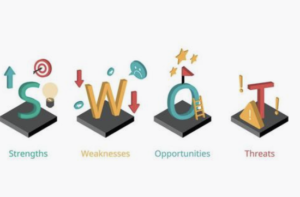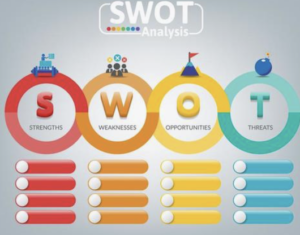How to Do a SWOT Analysis for Your Affiliate Marketing Business: 29 Points
We may earn money or products from the companies mentioned in this post.
I. Introduction
A. Brief overview of How to Do a SWOT Analysis for Your Affiliate Marketing Business

SWOT analysis is a strategic planning tool used to assess and analyze the internal and external factors that can impact the success of a business or project. The acronym SWOT stands for strengths, weaknesses, opportunities, and threats, representing the key elements examined during the analysis.
- Strengths: These are the internal, positive attributes or characteristics that give an organization a competitive advantage. Identifying strengths helps leverage existing resources and capabilities.
- internal factors that may hinder or pose challenges to the success of the business. Acknowledging one’s shortcomings enables proactive fixes and advancements.
You may be interested: How to Attack Affiliate Marketing, What Should You Avoid Doing?
Opportunities:
External factors that the business can capitalize on to achieve its objectives. Identifying opportunities enables organizations to align their strategies with potential areas of growth.
- external elements that could potentially harm the business. Recognizing threats helps in developing strategies to mitigate risks and navigate challenges.
SWOT analysis is a versatile tool used across various industries and sectors, providing a comprehensive understanding of the current state of affairs and guiding strategic decision-making processes. It serves as a foundation for creating actionable plans to maximize strengths, address weaknesses, seize opportunities, and mitigate threats.
B. Importance of applying SWOT Analysis to your affiliate marketing business

Applying a SWOT analysis to your business is important for many reasons. It provides information that can help you make better decisions and improve your overall performance.
You may like: Rytr – The Most Affordable Call to Action, Intro, Conclusions, and more
- Strategic Planning: SWOT analysis helps businessmen involved in starting a business. A clear and informed strategic plan, identifying internal strengths and weaknesses as well as external opportunities and threats. This helps in getting the job done with the goals achieved.
- Competitive Advantage: By understanding the strengths and weaknesses of a marketing strategy, marketers can use the performance of that strategy to gain a competitive advantage. It allows the development of unique sales and effective differentiation strategies.
- Resource allocation: SWOT analysis helps in improving resource allocation. Understanding strengths and weaknesses helps prioritize resources for maximum impact when investing in technology, talent, or business management.
- Risk Mitigation: Identifying threats in the external environment allows business partners to work together to respond to these risks. Assists in the development of contingency plans and strategies to effectively solve problems and reduce the impact of external threats.
- Professionalism Most Popular Articles: It helps identify potential partners and areas of expansion, leading to business growth.
- Competitive objectives: SWOT analysis ensures that business objectives are aligned with internal and external realities. It helps create realistic and achievable goals based on the organization’s strengths and market opportunities.
- Continuous Improvement: SWOT analysis is not a one-time exercise; it encourages continuous improvement. Regularly reviewing the analysis helps companies adapt and adjust their strategies according to changes in business and internal development.
Using SWOT analysis for business partners provides a comprehensive framework and methodology to evaluate business positions, improve operational efficiency, and make informed decisions about long-term success.
II. Strengths

A. Identifying unique strengths of the affiliate marketing business
There are many advantages that make affiliate marketing popular and successful:
- Low Barrier to Entry: Affiliate marketing is open to people with varying skill levels and financial resources. Barriers to entry are low, and new entrants can start introducing products and making profits without needing large investments.
- Multiple Opportunities: Associates have the flexibility to promote multiple products and services in different areas. This diversity allows many people to explore and benefit from a variety of economic opportunities that contribute to their interests.
- Scalability: The affiliate marketing model is highly scalable. Affiliates can increase business revenue by expanding their reach, exploring new products, or launching various promotions.
- No product development or product management is required. Affiliates are not required to develop or own the products they support. This simplifies the business model by eliminating the need for production, inventory control, and fulfillment.
- Performance-Based Compensation: Affiliate marketing uses a performance-based model where affiliate marketers earn commissions based on the results they deliver. This increases the interest of partners and sellers and encourages collaboration to ensure good traffic and sales.
- Global Exposure: The digital nature of affiliate marketing allows affiliate marketers to reach a global audience. Affiliates can gain significant benefits and revenue by promoting their products to international markets.
- DISCLAIMER: Partners are not responsible for customer support, as it is the responsibility of the product or service owner. This allows partners to focus on advertising and distribution efforts without the responsibility of managing customer questions or issues.
- Data-Driven Analytics: Affiliate marketing platforms often provide powerful metrics and reporting tools. Affiliate marketing companies can use this information to monitor the effectiveness of marketing campaigns, understand target audience behavior, and improve their strategies to achieve good results.
Overall, the unique advantages of affiliate marketing make it an attractive and accessible opportunity for individuals and businesses looking to generate online income through advertising strategies and affiliates.
Related: How To Secrets of Writing an Affiliate Marketing Article 10 Tips
B. Leveraging expertise and resources

Examples: Strong online presence, niche expertise, effective marketing strategies
- Online power: Online power is the main benefit of affiliate marketing. Affiliates with a strong online presence, such as a popular blog, social media followers, or a successful YouTube channel, have a ready audience. You can use your target audience’s trust to your advantage to market a quality product. A strong online presence increases trust in marketers, makes their recommendations more valuable, and leads to more conversions.
- Niche Expertise: Niche expertise is an important asset in affiliate marketing. Affiliates that specialize in a niche or industry can target audiences with specific needs and interests. This skill allows partners to become trusted authorities in their business and build a strong relationship with their target audience. Niche experts allow affiliates to curate content that resonates with their target audience and provide insights and recommendations based on their target audience.
- Good Marketing Strategy Good marketing is essential to the success of affiliate marketing. This involves using a variety of techniques to promote products, such as content marketing, email marketing, social media, and search engine optimization (SEO).
- Active marketers who understand their target audience and adjust their strategies accordingly can create meaningful content that encourages engagement and conversion. The ability to implement and adjust marketing strategies based on analytics and performance data is a key differentiator for successful affiliates. A good business strategy ensures that the partnership is effective and profitable.
III. Weaknesses

A. Recognizing areas of improvement
Acknowledging areas that need improvement is an important part of any growth-oriented program for success. In both personal and professional situations, recognizing weaknesses or areas that need strengthening leads to success.
It involves a sense of self that transcends achievement and an emotional perspective that encourages continuous learning and growth. Knowing the areas open to development in all sectors, from business to personal development, will make a positive difference.
It allows individuals and organizations to set realistic goals, implement strategic plans, and ultimately succeed in a dynamic and ever-changing environment. Embracing a culture of improvement fosters resilience, adaptability, and a commitment to continuous excellence.
You may like: How To Craft Distinctive and Quality Content to Engage Your Audience 5 Pro Tips
B. Addressing challenges and limitations
Acknowledging areas that need improvement is an important part of any growth-oriented program for success. In both personal and professional situations, recognizing weaknesses or areas that need strengthening leads to success.
It involves a sense of self that transcends achievement and an emotional perspective that encourages continuous learning and growth. Knowing the areas open to development in all sectors, from business to personal development, will make a positive difference.
It allows individuals and organizations to set realistic goals, implement strategic plans, and ultimately succeed in a dynamic and ever-changing environment. Embracing a culture of improvement fosters resilience, adaptability, and a commitment to continuous excellence.
C. Examples:
Limited budget, lack of diverse product offerings, competition analysis
Doing business with a limited budget presents both challenges and opportunities. Although financial constraints limit the initial investment in advertising or equipment, they encourage a greater allocation of resources.
Affiliates can focus on marketing benefits like content creation and organic marketing to maximize their impact without straining their budgets. Additionally, the challenge of a limited budget encourages creativity in finding new ways to achieve the lowest cost.
However, a lack of product diversity can cause limitations. Partners facing this challenge should explore expanding their niche or find additional partnerships to diversify their products. It also becomes important to do a good competitive analysis.
Understanding competitors allows partners to identify gaps in the market, adjust unique selling propositions, and develop strategies to differentiate themselves in the marketplace. A combination of budget management, diversification efforts, and competitive analysis can make affiliates successful despite initial limitations.
IV. Opportunities

A. Exploring external factors for growth
Exploring external factors for growth and opportunities is a vital component of strategic planning for any business or endeavor. In the context of affiliate marketing, external factors encompass a range of elements beyond the affiliate’s immediate control but hold the potential to drive growth. This exploration involves staying attuned to market trends, consumer behaviors, and industry developments.
By monitoring shifts in the external landscape, affiliates can identify emerging opportunities and position themselves to capitalize on them. This could include adapting to changes in consumer preferences, leveraging advancements in technology, or tapping into new and underserved markets.
Successful affiliates actively seek out external influences that match their strengths and interests, allowing them to change and evolve in response to the dynamic nature of the online environment.
This forward-thinking approach allows our affiliates to not only adapt to change but also identify and seize new opportunities for sustainable growth and success.B. Identifying emerging trends and market gaps Examples: Expanding to new markets, adopting innovative technologies, collaboration opportunities
V. Threats
A. Assessing external challenges and potential risks
Assessing external challenges and potential risks, commonly referred to as threat analysis, is a crucial aspect of strategic planning in affiliate marketing.
Threats can emerge from various external factors, such as changes in market trends, shifts in consumer behavior, or increased competition. By identifying and understanding these threats, affiliates can proactively develop strategies to mitigate risks and navigate challenges effectively.
For example, staying informed about changes in search engine algorithms or evolving regulatory landscapes helps affiliates anticipate potential disruptions to their marketing efforts.
Additionally, analyzing competitive threats provides valuable insights into market dynamics, allowing affiliates to adjust their positioning and differentiate themselves.
A comprehensive threat assessment can help branches adapt to the ever-changing digital environment, protect the business from potential risks, and build resilience in the face of external challenges.
B. Preparing for industry changes and competition

Examples: Market saturation, changes in regulations, evolving consumer preferences
Being prepared for industry and competitive changes is a fundamental aspect of staying relevant and successful in the dynamic affiliate marketing environment.
Recognizing that change is constant, affiliates must anticipate industry shifts, technological advancements, and changing consumer preferences. This includes gaining insight into upcoming trends, new technologies, and potential disruptions that may impact the affiliate marketing ecosystem.
It is also very important to closely monitor the competitive environment. Regular competitive analysis helps affiliates understand market trends, identify competitor strategies, and identify opportunities for differentiation.
This preparation is not about reacting to change but about strategically positioning your affiliate marketing business to be flexible, adaptive, and innovative in response to industry changes and competitive dynamics.
By maintaining a competitive edge, affiliates can use change as an opportunity for growth rather than a threat to success.
VI. SWOT Analysis and Integration
SWOT analysis and its integration play a key role in strategic decision-making for companies, including affiliate marketing businesses. SWOT, which stands for Strengths, Weaknesses, Opportunities, and Threats, is a comprehensive framework for assessing internal and external factors affecting a business.
SWOT integration involves combining the results from each category to form a coherent strategy. Companies can leverage their strengths to leverage internal advantages by linking them with external capabilities.
For example, if your partner has a strong online presence (strength), you can explore new market segments or collaborate on products with high potential (opportunity). This integration provides a proactive approach to growth.
Likewise, it is more effective to address weaknesses related to external threats. Once limited budgets (weaknesses) are identified, integration involves finding cost-effective strategies to mitigate potential competitive issues or industry changes (threats).
SWOT integration ensures that internal capabilities are aligned with external factors, creating actionable information. This holistic approach helps you develop strategies that not only leverage strengths and opportunities, but also address weaknesses and mitigate threats.
It forms the basis of a comprehensive and adaptable business strategy in the dynamic affiliate marketing environment.
More Reading: Eye-opening Affiliate Marketing News and Update Now 10 Pro Tips
A. Combining strengths and opportunities for growth

Combining strengths and opportunities for growth is a strategic approach that lies at the core of successful business planning, including in affiliate marketing. Strengths represent internal capabilities and advantages, while opportunities are external factors that can be leveraged for business expansion.
When these two aspects are synergistically aligned, it creates a powerful strategy for sustained growth. For example, if an affiliate marketer possesses a strong online presence and a loyal audience (strength), they can capitalize on opportunities by introducing new and relevant products to their existing audience or expanding into complementary niches.
This alignment allows for the maximization of existing strengths to tap into new markets or revenue streams. Moreover, combining strengths and capabilities can include strategic collaborations with other companies, optimizing marketing efforts, and implementing innovative technologies to improve your overall affiliate marketing strategy.
This integration allows growth initiatives to benefit from the company’s internal capabilities as well as external factors tailored to its strengths.
Ultimately, the synergy of strengths and capabilities creates a strong foundation for expansion, adaptation to market changes, and long-term success in the highly competitive affiliate marketing environment.
B. Mitigating weaknesses and addressing threats
Addressing weaknesses requires identifying strategies to overcome internal challenges. For example, if an affiliate marketer views the lack of a diverse product offering as a weakness, they may seek opportunities to participate in additional affiliate programs or expand their niche expertise.
To combat threats, it is necessary to develop strategies to respond to external challenges. Once threats such as increased competition are identified, affiliates can focus on differentiation strategies, improving marketing techniques, or targeting untapped market segments. It is important to integrate these efforts.
For example, when a limited budget (weakness) is combined with the threat of changing market dynamics, integration involves finding cost-effective marketing approaches and applying strategies to remain competitive.
Ultimately, by systematically addressing weaknesses and eliminating threats, affiliate marketers increase resilience, strengthen their market position, and create stronger, more adaptable business models in the dynamic affiliate marketing environment.
C. Developing actionable strategies based on analysis

Developing actionable strategies based on analysis is the culmination of a thorough examination of internal and external factors, often achieved through tools like SWOT analysis. This phase involves translating insights gained from the analysis into practical and effective courses of action.
For strengths and opportunities, the focus is on maximizing and leveraging existing capabilities. If, for example, the analysis reveals a strength in niche expertise and an opportunity in a growing market segment, the actionable strategy could involve creating targeted content or promotions to capture the attention of that specific audience.
On the other hand, weaknesses and threats necessitate strategic interventions for mitigation. Once weaknesses are identified in the form of limited distribution channels and the resulting threat of changing consumer behavior, viable strategies may include diversifying distribution channels to adapt to evolving trends.
Developing such a strategy requires a clear understanding of business objectives, realistic resource estimates, and an implementation schedule. This involves bridging identified strengths and opportunities while addressing and mitigating weaknesses and threats.
The result is a comprehensive and actionable plan that will ensure the success of your affiliate marketing business in a dynamic and competitive environment.
Business Opportunity
- Free domain name
- Free basic training
- Opportunity of earning a commission
- No credit cart needed
VII. Implementation
A. Creating an action plan based on SWOT findings
Creating an action plan based on your SWOT results is an important step in turning your analysis into an actionable strategy for affiliate marketing success. An action plan is a roadmap that leverages strengths, addresses weaknesses, capitalizes on opportunities, and mitigates threats.
1. Leverage your strengths:
identify your key strengths, such as a strong online presence, niche expertise, and a loyal audience. Develop strategies to maximize these strengths, including creating high-quality content, engaging audiences, and optimizing existing successful channels.
2. Defect Removal:
Recognize weaknesses such as limited distribution channels, tight budgets, and a narrow product range. Develop actionable steps to address these shortcomings, including diversifying marketing channels, optimizing budget allocation, and exploring new affiliate programs.
3. Use the function:
Identify external opportunities such as new trends, new product launches, and untapped markets. Develop strategies to capitalize on these opportunities, including creating targeted content, expanding relevant niches, and forming strategic partnerships.
4. Threat Reduction:
Recognize external threats such as increased competition, changes in legislation, and changes in consumer behavior. Develop a proactive plan to mitigate these threats, such as identifying industry trends, diversifying your products, or improving your marketing strategy to ensure agility.
5. Timeline and Responsibilities:

Establish a timetable for executing each aspect of the action plan. Clearly define responsibilities to ensure effective implementation of the plan.
6. Regular evaluation and adjustment:
Periodically evaluate the implementation of the action plan. Adapt your strategy to new developments, feedback, and changes in the business environment. In essence, an action plan based on SWOT results is a dynamic tool that guides your affiliate marketing business toward its goals while promoting adaptability and responsiveness to the ever-changing digital environment.
B. Setting measurable goals and timelines
Setting quantifiable objectives and timelines could be a crucial aspect of arranging an associate promotion technique. This incorporates characterizing particular, measurable goals and setting a clear timeline to realize them. This approach clarifies the branch’s vision and gives a guide for advance and victory. Here’s how the method unfolds:
1. Characterize quantifiable objectives:
Objectives ought to be particular and quantifiable, such as accomplishing a certain number of clicks, conversions, or income within a certain time period. Illustration: Increase your month-to-month member wage by 20% within the next quarter.
2. Concur on objectives utilizing SWOT examination:
Objectives ought to be specifically adjusted with the conclusions gotten from the SWOT examination. For illustration, if you recognize the qualities of your specialty through a SWOT investigation, your objective could be to become a recognized specialist in that specialty within six months.
3. Set a due date:
Clearly characterize the time outline over which objectives are anticipated to be accomplished. Illustration: Increment site activity by 15% over the next 2 months.
4. Break down your objectives into viable steps:
Break enormous objectives into littler, more significant steps. This may incorporate week-after-week or month-to-month objectives that contribute to your general objective.
5. Normal observation and alteration:
Make a framework to frequently screen progress toward accomplishing your objectives. Alter the plan or technique as required based on the current assessment.
6. Guarantee reasonable and achievable objectives:

Objectives must be practical, taking into consideration accessible resources and showcase conditions. Setting achievable objectives increases your sense of achievement and motivation.
By setting quantifiable objectives and timelines, affiliates not only give a clear heading for their endeavors but also a system to degree execution, make educated choices, and give an economical way to victory within the competitive member showcasing environment. We offer work.
C. Regularly reviewing and adjusting strategies
Regularly reviewing and adjusting strategies is a crucial component of effective affiliate marketing management. The dynamic nature of the digital landscape, coupled with changing market conditions, requires affiliates to adopt an agile and adaptive approach. Here’s why regular review and adjustment are essential:
- Performance Evaluation: Ongoing assessment of key performance indicators (KPIs) provides insights into the effectiveness of current strategies. Identifying what works and what doesn’t helps refine approaches for optimal results.
- Adaptability to Market Changes: Consumer habits, market conditions, and industry trends are dynamic. Regular reviews allow affiliates to stay abreast of these changes and adjust strategies accordingly.
- Technology and algorithm updates: Platforms and search engines frequently update algorithms and features. Regular reviews ensure that affiliates adapt to these changes to maintain visibility and performance.
- Competitive Landscape: Monitoring competitors is essential. Regular reviews enable affiliates to understand competitive strategies, identify gaps, and position themselves effectively.
- Feedback and Audience Engagement: Feedback from the audience provides valuable insights. Regular reviews help in understanding audience preferences and adjusting content or promotions accordingly.
- Optimizing Budget Allocation: Budgets may need adjustments based on the performance of different channels. Regular reviews enable affiliates to optimize budget allocations for maximum impact.
- Incorporating New Opportunities: The digital landscape is dynamic, presenting new opportunities. Regular reviews help affiliates identify and capitalize on emerging trends or untapped markets.
- Continuous Improvement: Affiliate marketing is an iterative process. Regularly reviewing and adjusting strategies is fundamental to a culture of continuous improvement, fostering resilience and long-term success.
By embracing a proactive stance through regular reviews and adjustments, affiliates can navigate the ever-changing affiliate marketing landscape with agility, ensuring sustained growth and relevance in a competitive environment.
More Reading: Affiliate Marketing and Business Opportunities Now Extra 10 Tips
VIII. Summary

A. Summary of SWOT analysis benefits for affiliate marketing business
A SWOT analysis provides valuable information for your affiliate marketing business, providing a comprehensive understanding of internal strengths and weaknesses as well as external opportunities and threats.
The benefits of SWOT analysis for affiliate marketing include:
1. Strategic Planning:
SWOT analysis forms the basis of strategic planning, helping affiliates align internal capabilities with external opportunities and promote a more focused and effective approach.
2. Competitive Advantage
By identifying strengths and combining them with opportunities, partners can create unique selling propositions to gain a competitive advantage in the marketplace.
3. Risk Mitigation:
By recognizing weaknesses and threats, affiliates can develop proactive strategies to reduce risks and ensure a more resilient business model.
4. Resource Optimization
SWOT analysis helps you optimize resource allocation by focusing on strengths and opportunities and making the most of available resources to achieve maximum impact.
5. Adaptability
Regularly reviewing the SWOT analysis allows partners to adapt to changing market conditions, technology updates, and changing consumer behavior.
6. Informed Decisions
The results obtained from a SWOT analysis help partners make informed decisions such as diversifying products, improving marketing strategies, and exploring new opportunities.
7. “Align Your Goals”
SWOT analysis encourages a strategic and focused approach that promotes long-term success by ensuring business goals are aligned with current reality.
8. Continuous Improvement
The iterative nature of SWOT analysis promotes a culture of continuous improvement, encouraging partners to regularly evaluate and improve their strategies for continued success in the dynamic affiliate marketing environment.
B. encouragement for ongoing strategic evaluation and adaptation.

Encouraging constant evaluation of strategies and adjustments is crucial to the success of your marketing strategy. An efficient and flexible approach is essential in the ever-changing digital world. How important it is to constantly monitor and change:
1. Dynamic market conditions.
Businesses are dynamic and can change quickly. Continuous measurement allows marketers to stay informed about changes in customers, business trends, and new opportunities.
2. Technological Progress
The digital world continues to evolve with the advancement of technology. Continuous evaluation allows partners to implement and integrate new technologies to improve their business strategies and overall performance.
3. competitive environment.
Competition in the affiliate marketing space is fierce. Regular evaluations can help you stay ahead of the competition by monitoring competitors, identifying winning strategies, and adjusting your approach for a competitive advantage.
4. Consumer Preferences:
Consumer preferences and expectations change over time. Constant change allows partners to create content and support that is effective and meets the needs of their audience.
5. Marketing Channel Optimization
It is very important to evaluate the results of different marketing channels. This can help you identify your best-performing sales pipeline, improve financial allocation, and develop strategies to maximize return on investment.
6. Integrate feedback
Audience feedback is an important source of information. Continuous evaluation support allows partners to provide feedback, respond to customer preferences, and strengthen relationships with the target market.
7. Goals are easy to set
You may need to adjust your goals and objectives based on performance data and business strategy. Regular evaluations make it easier to adjust your goals to ensure they remain realistic, effective, and relevant to the changing business environment.
8. Troubleshooting preparation
Regular testing ensures that the branch is prepared for unexpected issues and problems. This allows you to create contingency plans and make adjustments quickly. Supporting ongoing strategic evaluation and adaptation is more than just re-evaluation. This is a proactive strategy for long-term success.
This creates a culture of innovation, resilience, and agility that is essential to succeeding in the dynamic and competitive affiliate marketing industry.
I hope How to Do a SWOT Analysis for Your Affiliate Marketing Business: 6 Tips was helpful.
I would much appreciate it if you could kindly leave your comments and questions below.
Thank You For Stopping By Once More
Thanks for reading my article
Till The Next Time
Elke
Author





